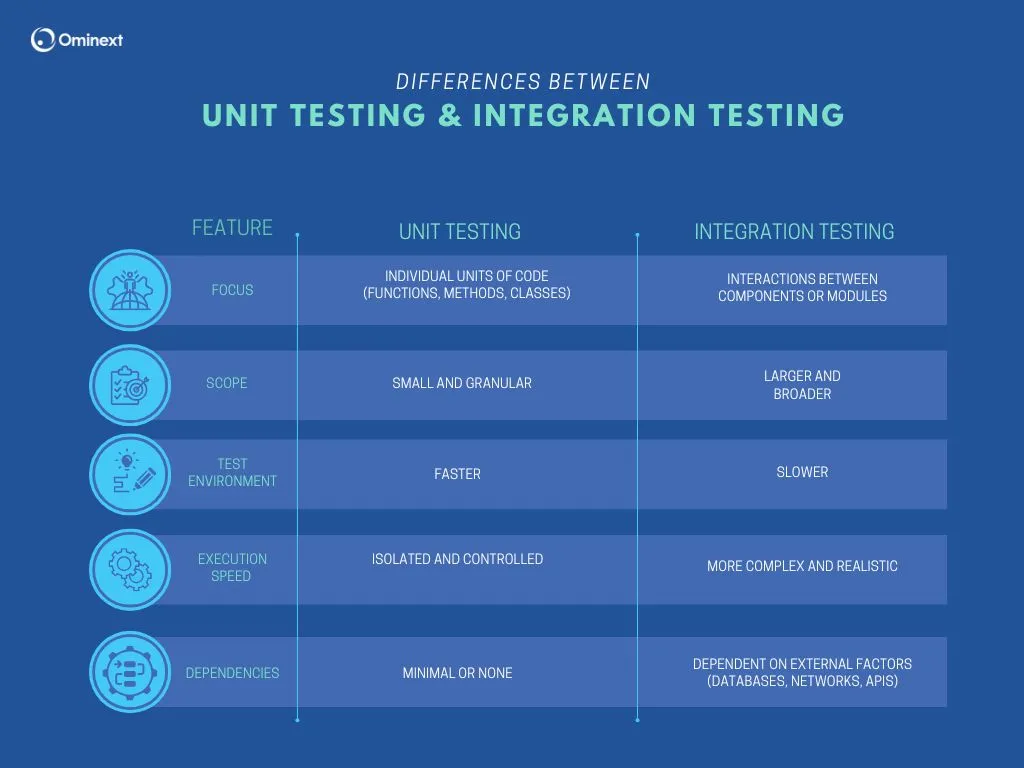What is the difference between unit testing and integration testing
In software development, testing is essential to ensure that applications are reliable and bug-free. There are two core methods, which are Unit testing and integration testing, each with unique purposes.
This article will explain the differences between unit and integration testing and when to use each to build robust software.
I. Unit Testing
1. What is Unit Testing?
Unit testing is a software testing method in which individual components, or "units," of an application are tested in isolation from the rest of the codebase. A "unit" typically refers to the smallest testable part of an application, such as a function, method, or class, that performs a specific task. The main goal of unit testing is to verify that each unit works as expected on its own, independent of other components.
2. Key Characteristics of Unit Tests
Small, Focused Tests
Unit tests are narrowly scoped, targeting specific methods, functions, or classes. By testing only a small piece of functionality, they are easier to write, understand, and debug. This precision allows developers to pinpoint the exact source of an issue when a test fails, simplifying the troubleshooting process.
Fast Execution
Since unit tests focus on tiny parts of the application, they run very quickly. This speed enables developers to execute tests frequently throughout the development cycle, catching errors early and often.

High Level of Control Over Test Environment
In unit testing, developers have control over the test environment, which includes configuring dependencies and external conditions specific to the unit being tested. By using techniques such as mocking or stubbing, developers can simulate parts of the code or external dependencies, allowing them to focus purely on the component being tested without interference from outside systems or states.
Independence from Other Tests
Unit tests are designed to be independent; they do not rely on the outcomes of other tests or the order in which they are run. This isolation ensures that each unit test provides a clear, accurate assessment of a single unit's behavior. Independent tests are also easier to maintain and manage since they are not affected by changes in other parts of the code.
3. Benefits of Unit Testing
Early Bug Detection
Unit testing allows developers to identify and fix bugs in the earliest stages of development. By isolating and testing individual components, issues are caught before they can propagate into larger, more complex parts of the application. This saves time and effort by preventing bugs from becoming embedded in the code, where they might require costly debugging later in the development cycle.

Improved Code Quality
Unit testing promotes better coding practices, encouraging developers to write modular, well-structured code that is easier to test. Components that are designed with testing in mind are typically simpler, more concise, and have fewer dependencies. This modularity enhances overall code quality, making the codebase more understandable, maintainable, and less prone to errors.
Facilitates Refactoring
When refactoring or updating code, developers can rely on unit tests to verify that changes have not introduced new issues. This "safety net" of tests gives developers the confidence to modify code, knowing that unit tests will catch any unintended consequences. As a result, code can be improved and optimized more frequently, leading to a cleaner and more efficient codebase over time.
Increased Code Coverage
By focusing on testing individual units of code, unit testing naturally leads to high code coverage. Increased coverage ensures that more parts of the application are tested, reducing the likelihood of undetected bugs. High coverage can also help identify untested or under-tested sections of the code, prompting developers to write additional tests and create a more robust application overall.
4. Common Unit Testing Frameworks and Tools
To effectively implement unit testing, developers rely on a variety of frameworks and tools. Here are some of the most popular ones:
Java
- JUnit: A widely-used framework for writing and running unit tests in Java. It provides a simple and intuitive API for creating test cases, assertions, and test suites.
- TestNG: A powerful testing framework that offers advanced features like data-driven testing, parallel execution, and flexible test configuration.
- NUnit: A popular unit testing framework for .NET languages, similar to JUnit in its approach and usage.
Python
- Pytest: A flexible and feature-rich testing framework that can be used for unit, functional, and integration testing. It offers a simple syntax, extensive plugin support, and seamless integration with other testing tools.
- unittest: The standard unit testing framework included in the Python standard library. It provides a basic set of tools for writing and running unit tests, but it can be less flexible and less user-friendly than Pytest.
JavaScript
- Jest: A popular JavaScript testing framework developed by Facebook. It's known for its ease of use, fast performance, and built-in mocking and snapshot testing capabilities.
- Mocha: A flexible and extensible JavaScript testing framework that can be used for both unit and integration testing. It offers a variety of plugins and reporters, allowing for customization and integration with other tools.
II. Integration Testing
1. What is Integration Testing?
Integration testing is a software testing approach that focuses on verifying the interactions between various components or modules of an application. Unlike unit testing, which tests individual units in isolation, integration testing examines how different parts of the application work together as a cohesive system. The main objective is to ensure that modules communicate and interact correctly, passing data and functioning as expected when combined.

2. Key Characteristics of Integration Tests
Integration tests verify how different modules of an application interact, ensuring that the combined functionality meets expectations. These tests are distinct from unit tests and come with specific characteristics:
Larger Scope than Unit Tests
Integration tests cover multiple components or modules working together rather than focusing on a single, isolated unit. This broader scope allows integration tests to examine data flow, inter-module communication, and system-level behavior. While unit tests focus on individual functions, integration tests give insight into how parts of the application operate collectively.
Slower Execution
Because integration tests involve multiple modules and often require connections to external systems (like databases or APIs), they are generally slower than unit tests. These dependencies increase the complexity and runtime of integration tests, which can lead to longer test cycles. This slower speed makes integration tests less suited to be run as frequently as unit tests, though they remain essential for verifying system stability.
Requires More Complex Test Setups
Integration tests typically need a complex setup, as they often rely on actual services, databases, or mocked environments. This setup might include configuring test databases, managing authentication, and handling data dependencies. To support testing across multiple modules, integration tests also require more setup and teardown processes, ensuring the system is in a consistent state before and after each test.
Dependent on External Factors (e.g., Databases, Network)
Integration tests often depend on external components such as databases, APIs, file systems, or network connections. This reliance on external factors introduces more variables, making tests susceptible to issues like network latency or downtime. These dependencies require careful handling, often through the use of mocks, stubs, or test doubles to replicate external systems when testing directly is impractical.
3. Benefits of Integration Testing
Validation of System Behavior
Integration testing confirms that multiple components, when combined, function as intended and support the overall system behavior. This testing verifies that the system as a whole meets requirements and behaves correctly across different parts of the application. Validating these interactions early in the process helps detect potential issues that may not be apparent in unit testing, providing a more accurate reflection of real-world system behavior.
Identification of Issues in Component Interactions
Many bugs occur at the boundaries between components, where data and control flow from one module to another. Integration testing focuses on these interfaces, helping to identify issues such as mismatched data formats, incorrect data handling, and unexpected outputs. By catching these interaction issues early, integration testing prevents cascading errors that could affect the functionality of multiple modules and become harder to debug in a live environment.
Improved System Reliability
Integration testing helps ensure that different parts of the system work together smoothly, which significantly enhances overall system reliability. By validating communication and data exchange between components, integration tests reduce the risk of failures in production. This improves the user experience and gives developers and stakeholders confidence that the application will perform reliably under various conditions.
4. Common Integration Testing Strategies
Several strategies can be employed to conduct effective integration testing. Here are some of the most common approaches:
Big Bang Integration Testing
In this approach, all components of the system are integrated and tested simultaneously. This method is often used for smaller systems or when time constraints are tight. However, it can be challenging to isolate and identify the root cause of issues, especially in large and complex systems.
Top-Down Integration Testing
Top-down integration testing starts with the top-level modules and progressively integrates lower-level modules. This approach can be effective for identifying high-level design flaws early in the testing process. However, it may require the use of stubs or test drivers to simulate the behavior of lower-level modules that are not yet integrated.
Bottom-Up Integration Testing
Bottom-up integration testing begins with testing the lowest-level modules and gradually integrates higher-level modules. This approach can be more efficient in terms of resource utilization, as it focuses on testing smaller, more manageable units of code. However, it may delay the testing of end-to-end functionality.
Sandwich Integration Testing
Sandwich integration testing combines elements of both top-down and bottom-up approaches. It involves testing both high-level and low-level modules simultaneously, integrating them in a layered fashion. This strategy can be effective in mitigating the drawbacks of the other two approaches, as it allows for early identification of issues at both ends of the system.
Unit Testing vs. Integration Testing: A Comparison
From these information above, we have a comparison table as below:

Conclusion
In conclusion, unit testing and integration testing are both crucial techniques for ensuring the quality and reliability of software applications. While unit testing focuses on the individual components, integration testing evaluates the interactions between these components. By understanding the differences between these two approaches and effectively implementing them, development teams can significantly improve the overall quality of their software.
Remember, a well-balanced testing strategy that incorporates both unit and integration testing is essential for building robust and reliable software systems.





